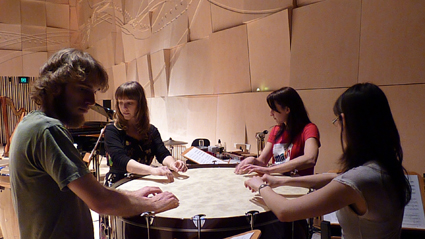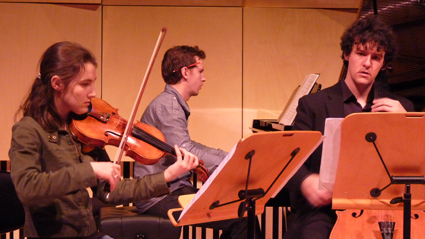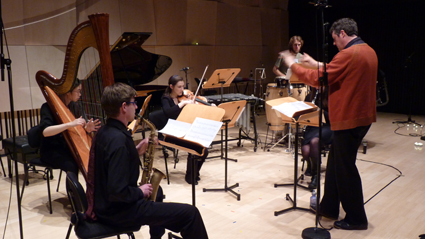technical, experimental, metaphysical
matthew lorenzon: fresh meat 2011

Chris Williams’ Il Pleut, Fresh Meat, 2011
photo Melody Eötvös
Chris Williams’ Il Pleut, Fresh Meat, 2011
THERE WAS A PALPABLE BUZZ OF EXCITEMENT AS ORGANISERS GLUED THEMSELVES TO MOBILE PHONES, ENSEMBLES REHEARSED LATE INTO THE NIGHT AND COMPOSERS FROM AROUND AUSTRALIA BOARDED BUDGET FLIGHTS IN THE LEAD UP TO FRESH MEAT 2011. PRESENTED BY MELBOURNE RECITAL CENTRE IN ASSOCIATION WITH THE NEW MUSIC NETWORK, THE EVENT SHOWCASED THE STRIKING DIVERSITY OF STYLES CURRENTLY BEING DEVELOPED BY EMERGING COMPOSERS. SIGNALLING A REFLECTIVE MUSIC SCENE, COMPOSERS COULD BE HEARD BALANCING TECHNICAL EXPERIMENTATION, METAPHYSICAL ANALOGY AND PROGRAMMATIC DEPICTION TO STARTLING AND THOUGHT-PROVOKING EFFECT.
the finite, the infinite & the infinitesimal
Melody Eötvös’ string quartet and Annie Hui-Hsinn Hsieh’s quartet for clarinet, violin, viola and piano were united by a Bartokian minor-mode lyricism and a rather sad metaphysics. In Olber’s Dance in the Dark based on Olber’s paradox—that the universe could not be infinite as then the night sky would be bright with an infinity of stars—Eötvös’ strident chords of increasing density gradually confirmed the universe’s finitude. A deflating proposition, until the increasing wonder of the chords’ harmonic invention leads one to contemplate the possibilities that are opened up by restriction, in this case the universe of tonal constellations.

Hui-Hsinn Hsieh’s Towards the Beginning
Hui-Hsinn Hsieh’s Towards the Beginning conjures a Taoist, cyclic universe. However, the interest of this piece is not in the ABA form that arises from its subtext, but in the composer’s use of timbre. Multiphonics—combining a fundamental tone and a higher, harmonic tone—on the clarinet and strings produce an ethereal atmosphere from which a fragmented, modal dirge emerges. The coalescing snatches of melody are shattered by a chord from the piano, leaving the original shimmering surface in its wake.
Chris Williams’ percussion piece Il Pleut (based on Apollinaire’s poem) builds textures from infinitesimal points of sound. Through a sort of instrumental granular synthesis, washes of attacks build into blocks of sound that shift as the percussionists explore different instrumentation. As an examination of “the tension between the musical finite and infinite,” the piece was most interesting at the threshold between a sound and its parts, when staggered attacks were on train to coalesce or break apart.
sound encounters
Three works on the program looked at the way different instruments altered the same musical material. This idea is very, very old. At least until the advent of electroacoustic music the main way to discuss timbre was with reference to instrumentation. As such, musical ideas have always been subject to instrumental comment, even—I would argue—when instrumentation was not indicated in scores, at which times convention would have dictated the distribution of instrumental resources. It is therefore up to performers or a program to keep such naked exploration interesting.
Timothy Tate’s Departures focuses on sonic analogues between the clarinet, viola and piano. Viola pizzicati are interpreted as clarinet tongue slaps and plucked piano strings while glissandi become runs and arpeggios. With rapid question and answer phrases, the composition reminded me of a slapstick Loony Toons score, though this comic air was not to be found in the performance.
Alex Pozniak’s From the Formless, on the other hand, was hilarious. Favouring superimposition over juxtaposition, From the Formless has a crowded and chaotic texture. Simon Charles, Peter Dumsday and Jonathan Heilbron played up the comical energy of this pandemonium as the instruments, or rather the instrumentalists, simultaneously tried to make the scratchiest, burbliest, quackiest noises possible.
Such compositional devices do not always have to be humorous. Luke Paulding’s quartet for flute, clarinet, double bass and percussion combined juxtaposition and superimposition of timbres in graceful sound poetry. Titled In Her sparkling flesh in saecular ecstasy, the point of the work was not to find sonic analogues, but neighbouring sounds that lead the ear along the curves of a sonic sculpture: to be precise, the sonic sculpture that Paulding draws from Richard Wilbur’s poem “A Baroque Wall Fountain in the Villa Sciarra.” The largely impressionist sonic palette flows and splashes like Wilbur’s fountain: cymbal crashes and an arcing ejaculation from the clarinet release the cascade that rushes through rattling skewers and strikes of the double bass bow on the strings (“flatteries of spray”), shimmering woodwinds (“a clambering mesh of water-lights”) and a truly incontinent “ragged, loose collapse of water” played by all. The work concludes much as it begins, with the somehow obscene burbling of a clarinet mouthpiece in a glass of water.
percussive programming

Amy Bastow’s Never OdD or Even, Fresh Meat, 2011
photo Melody Eötvös
Amy Bastow’s Never OdD or Even, Fresh Meat, 2011
Amy Bastow’s Never OdD or Even is a musical take on Obsessive Compulsive Disorder. Having suffered from OCD and Tourette’s Syndrome as a child I did feel a little uncomfortable when the ensemble entered the salon twitching and counting their steps. “Is this funny?” I asked myself. I suppose so, even if I couldn’t shake a certain sadness that stole over me during the performance. OCD is a living nightmare. The compulsion itself is less like a desire to be fulfilled than a pursuer in those dreams where you can’t run properly. Bastow brilliantly captures the persistent, exhausting nature of OCD. Right when it seems the driving rhythms, mockingly major-mode additive phrases and frenzied tempi have ceased they are back, louder and faster than ever. I particularly like Bastow’s wearied lyrical passages that express something of the beleaguered exhaustion proper to a day of obsessive counting, retraced steps and compulsive twitching. With a similar demonic force, Anthony Moles took the idea of small machines within larger machines to produce a driving solo piano piece, just as manically as mechanically performed by Peter Dumsday.
Invigorating works that would otherwise lie dormant in computer files, the performers’ commitment deserves special mention. In particular, clarinettist Karen Heath seemed to hold many of the performances together with the gestures and physical intensity proper to performing in small ensembles. The power of the performer was evident not only in the above works, but in the inspired execution of Joseph Twist’s jazzy Le Tombeau de Monk, Mark Wolf’s grotesque Hamarøy Troll, Mark Oliviero’s electro-acoustic memoir Tanox, and Nicole Murphy’s composition for ballet Eve.
Melbourne Recital Centre & New Music Network, Fresh Meat, 2011, composers Amy Bastow, Alex Pozniak, Annie Hui-Hsin Hsieh, Luke Paulding, Timothy Tate, Melody Eötvös, Chris Williams, Nicole Murphy, Anthony Moles, Mark Wolf, Mark Olivero and Joseph Twist; Salon, Melbourne Recital Centre, Aug 25
For more on young composers see review of Breaking Out at Totally Huge New Music 2011
RealTime issue #105 Oct-Nov 2011 pg. web






